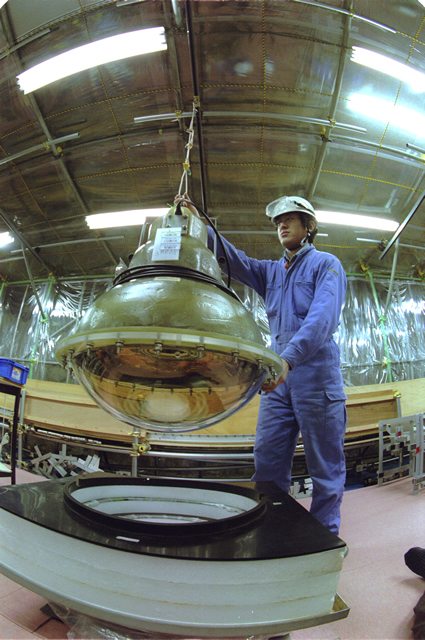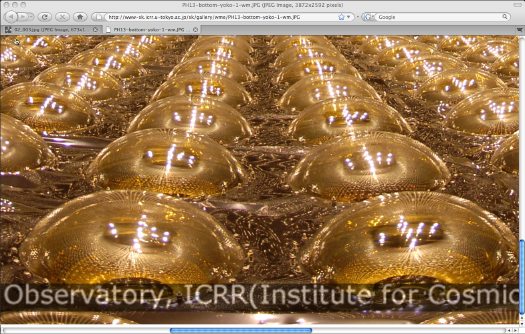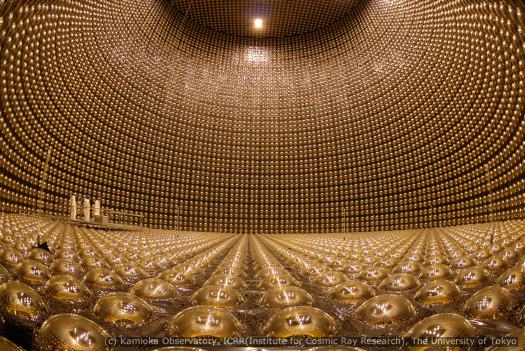 Photomultiplier Tubes, or PMT, are vacuum tubes used to detect electromagnetic energy. In 1979, Hamamatsu Photonics began development of the world's largest PMT, 25 inches across, which would be used in the Kamiokande proton decay detector being constructed by the University of Tokyo in a mine in rural Japan.
Photomultiplier Tubes, or PMT, are vacuum tubes used to detect electromagnetic energy. In 1979, Hamamatsu Photonics began development of the world's largest PMT, 25 inches across, which would be used in the Kamiokande proton decay detector being constructed by the University of Tokyo in a mine in rural Japan.
Within a year, Hamamatsu had managed to design a 20-inch (50cm) PMT, and successfully manufactured it by 1981. It was dubbed the model R1449:
Because this was a 20-inch PMT, the biggest question was whether or not its cathode could be manufactured correctly. The days leading up to the completion of the first PMT were anxious. Moreover, in steps such as antimony evaporation, there was no other recourse but to rely on the eyes and judgment of those professionals performing the tube evacuation task. An ordinary PMT can be held in the worker's hand throughout the production process, but the large 20-inch PMT first had to be secured in place. Then, the worker could perform his required tasks while walking around the outside of the PMT. The workers donned protective helmets equipped with explosion masks, mounted steps to the platform holding a large pumping bench, and began the final fabrication, which consisted of making the photocathode and sealing the PMT.Hamamatsu delivered 1,050 R1449 PMTs to Kamiokande, where they lined a giant tank of ultra-purified water 1,000 meters below the surface.The color formed from oxygen discharge in the photocathode manufacturing process was visually attractive. When made to react with potassium after antimony evaporation, the tint immediately changed to an ideal color for a photocathode. Cheers arose from the staff gathered around the pumping bench, as it was a moment of high emotion for everyone.

In 1987, the PMT array at Kamiokande detected for the first time neutrinos given off by a supernova. [It was a discovery for which Professor Masatoshi Koshiba [above], who spearheaded the Kamiokande research, was awarded the Nobel Prize in 2002. Those may be the two most awkwardly constructed sentences in this post.]
Meanwhile, an even larger detector was being planned for Kamiokande. Dubbed Super-K, the new tank, 39m high and 41m in diameter, would hold 50,000 tons of water and 11,200 PMTs. These new, improved PMTs, known as model R3600, were based on the R1449. They cover approximately 40% of the interior surface of the tank. Super-K began operations in 1996.
On November 12, 2001, as the tank was being refilled, a PMT imploded, sending a shock wave through the water, and causing a chain reaction which destroyed around 6,600 other PMTs.

The survivors were redistributed, protective acrylic shells were added, and research resumed. Beginning in 2005, newly manufactured R3600s were installed. The detector reopened in 2006 as Super-K-III.

According to reports at the time of the implosion, an R3600 cost around $3,000 new, an extremely reasonable price for such a magnificently crafted object. I would most definitely like one. Also a convenient display stand. Also, that tank is absolutely stunning. If I were a sculptor of shiny round objects of a hundred feet or more in diameter, I would find it hard to get out of bed in the morning knowing this exists.

20-Inch Photomultiplier Development Story [hamamatsu.com, the original Japanese version is a little more dramatic]
portrait of Prof. Koshiba hugging a Hamamatsu R3600 [u-tokyo.ac.jp]
hi-res images in the Super-Kamiokande photo album [ICCR at U-Tokyo]
Accident grounds neutrino lab [physicsworld]












